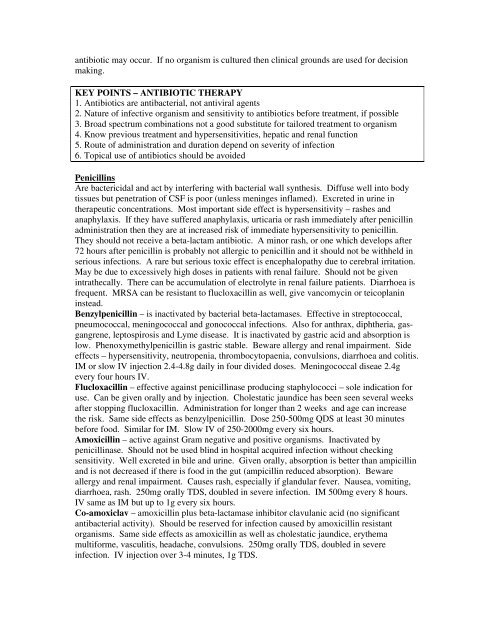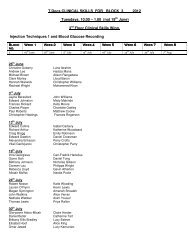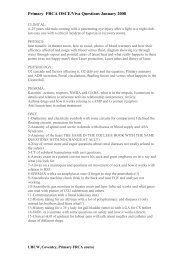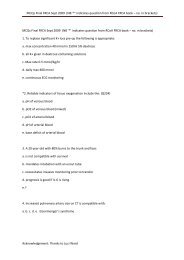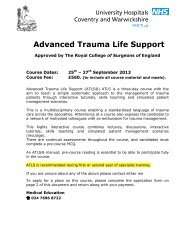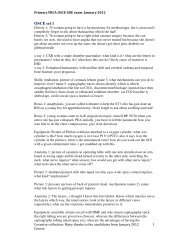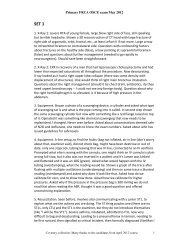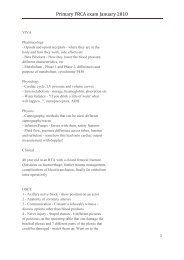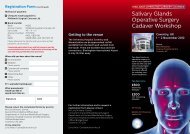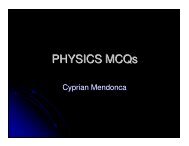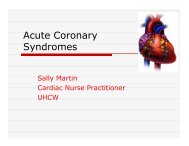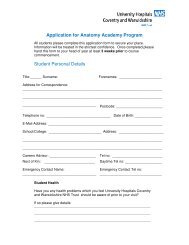DRUGS RELATED TO RESPIRATORY SYSTEM
DRUGS RELATED TO RESPIRATORY SYSTEM
DRUGS RELATED TO RESPIRATORY SYSTEM
Create successful ePaper yourself
Turn your PDF publications into a flip-book with our unique Google optimized e-Paper software.
antibiotic may occur. If no organism is cultured then clinical grounds are used for decisionmaking.KEY POINTS – ANTIBIOTIC THERAPY1. Antibiotics are antibacterial, not antiviral agents2. Nature of infective organism and sensitivity to antibiotics before treatment, if possible3. Broad spectrum combinations not a good substitute for tailored treatment to organism4. Know previous treatment and hypersensitivities, hepatic and renal function5. Route of administration and duration depend on severity of infection6. Topical use of antibiotics should be avoidedPenicillinsAre bactericidal and act by interfering with bacterial wall synthesis. Diffuse well into bodytissues but penetration of CSF is poor (unless meninges inflamed). Excreted in urine intherapeutic concentrations. Most important side effect is hypersensitivity – rashes andanaphylaxis. If they have suffered anaphylaxis, urticaria or rash immediately after penicillinadministration then they are at increased risk of immediate hypersensitivity to penicillin.They should not receive a beta-lactam antibiotic. A minor rash, or one which develops after72 hours after penicillin is probably not allergic to penicillin and it should not be withheld inserious infections. A rare but serious toxic effect is encephalopathy due to cerebral irritation.May be due to excessively high doses in patients with renal failure. Should not be givenintrathecally. There can be accumulation of electrolyte in renal failure patients. Diarrhoea isfrequent. MRSA can be resistant to flucloxacillin as well, give vancomycin or teicoplanininstead.Benzylpenicillin – is inactivated by bacterial beta-lactamases. Effective in streptococcal,pneumococcal, meningococcal and gonococcal infections. Also for anthrax, diphtheria, gasgangrene,leptospirosis and Lyme disease. It is inactivated by gastric acid and absorption islow. Phenoxymethylpenicillin is gastric stable. Beware allergy and renal impairment. Sideeffects – hypersensitivity, neutropenia, thrombocytopaenia, convulsions, diarrhoea and colitis.IM or slow IV injection 2.4-4.8g daily in four divided doses. Meningococcal diseae 2.4gevery four hours IV.Flucloxacillin – effective against penicillinase producing staphylococci – sole indication foruse. Can be given orally and by injection. Cholestatic jaundice has been seen several weeksafter stopping flucloxacillin. Administration for longer than 2 weeks and age can increasethe risk. Same side effects as benzylpenicillin. Dose 250-500mg QDS at least 30 minutesbefore food. Similar for IM. Slow IV of 250-2000mg every six hours.Amoxicillin – active against Gram negative and positive organisms. Inactivated bypenicillinase. Should not be used blind in hospital acquired infection without checkingsensitivity. Well excreted in bile and urine. Given orally, absorption is better than ampicillinand is not decreased if there is food in the gut (ampicillin reduced absorption). Bewareallergy and renal impairment. Causes rash, especially if glandular fever. Nausea, vomiting,diarrhoea, rash. 250mg orally TDS, doubled in severe infection. IM 500mg every 8 hours.IV same as IM but up to 1g every six hours.Co-amoxiclav – amoxicillin plus beta-lactamase inhibitor clavulanic acid (no significantantibacterial activity). Should be reserved for infection caused by amoxicillin resistantorganisms. Same side effects as amoxicillin as well as cholestatic jaundice, erythemamultiforme, vasculitis, headache, convulsions. 250mg orally TDS, doubled in severeinfection. IV injection over 3-4 minutes, 1g TDS.


